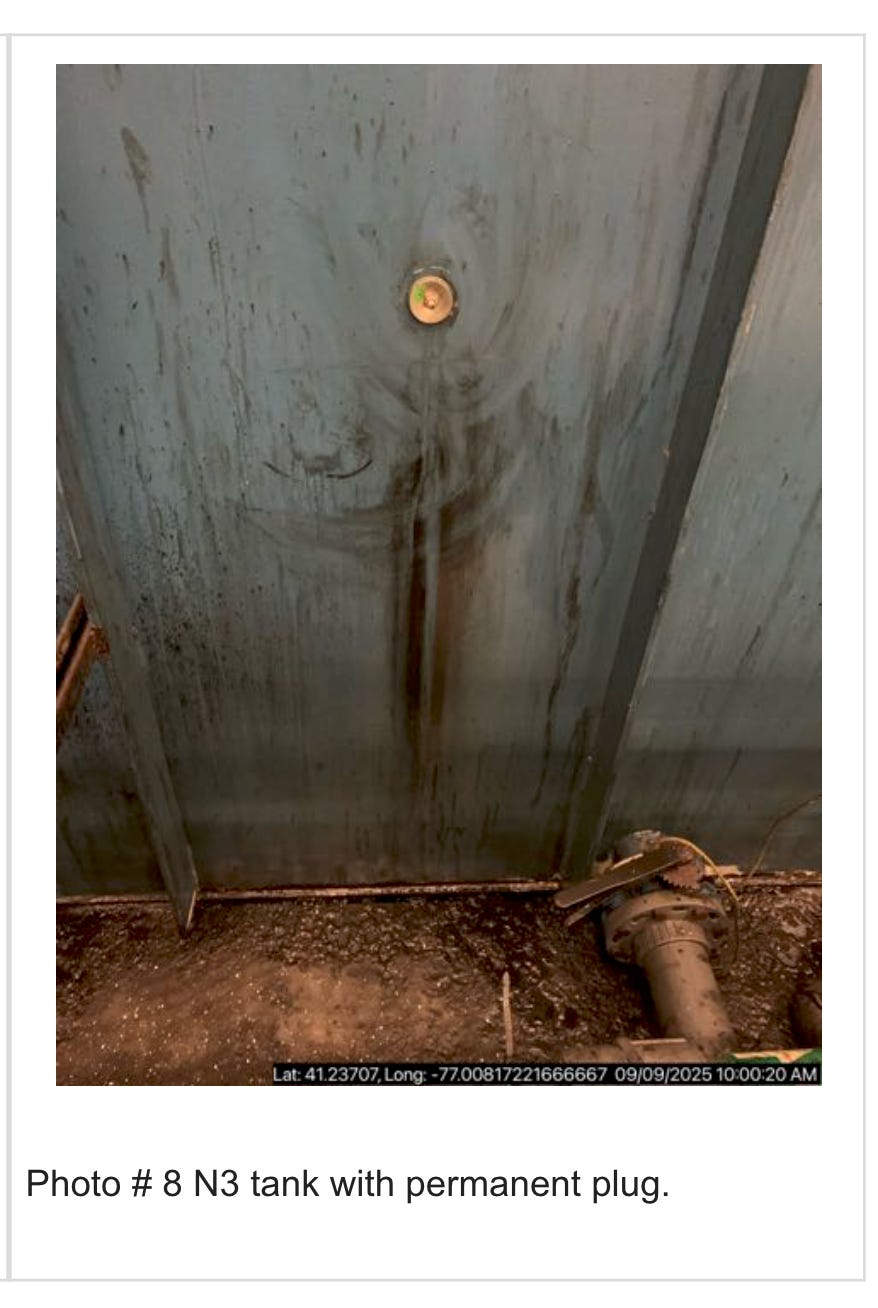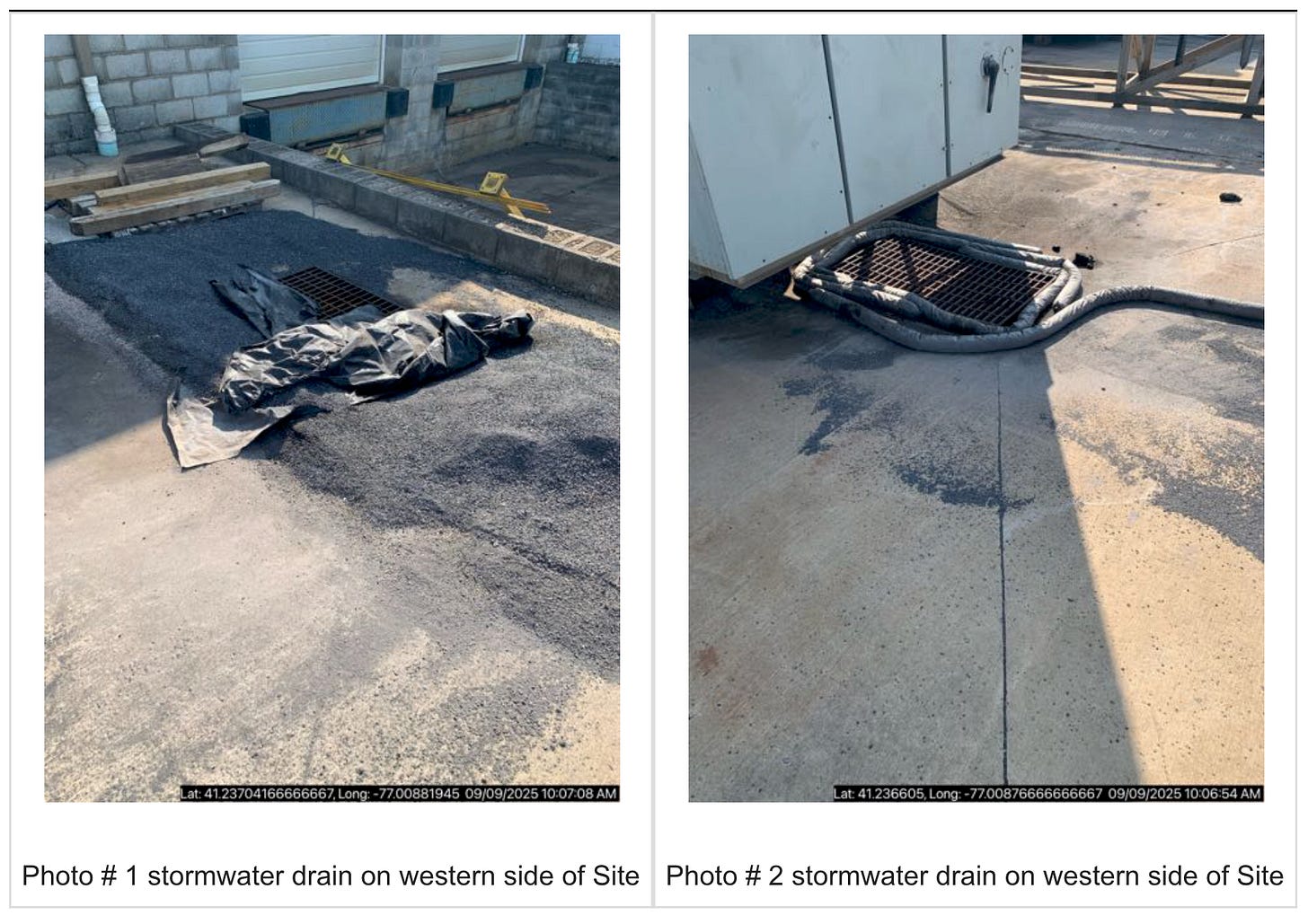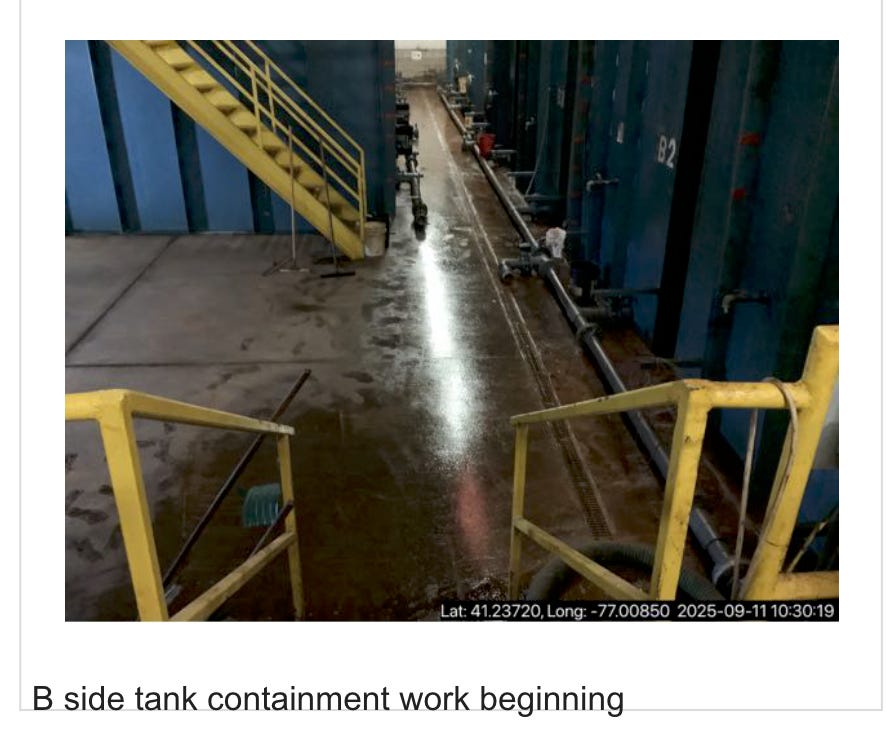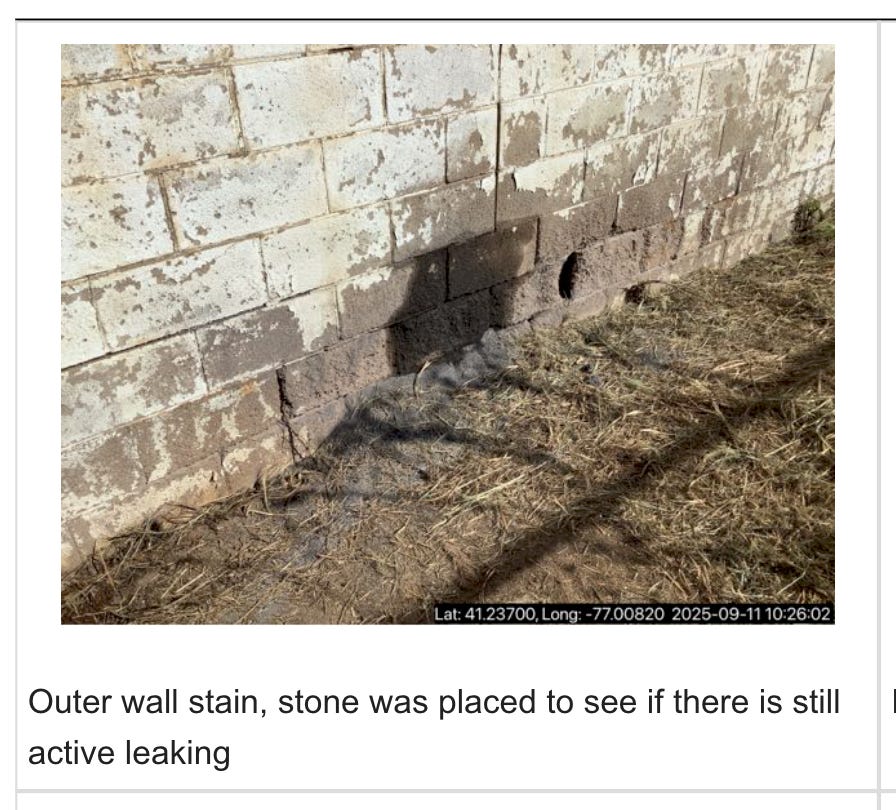Twenty-Six Days Later: DEP Logs Cleanup at Eureka — Still No Radium Tests, & Company Now Floats Lower Spill Totals
"There’s a lot of radium associated with all this and if it doesn’t get put somewhere safe people are going to get hurt."
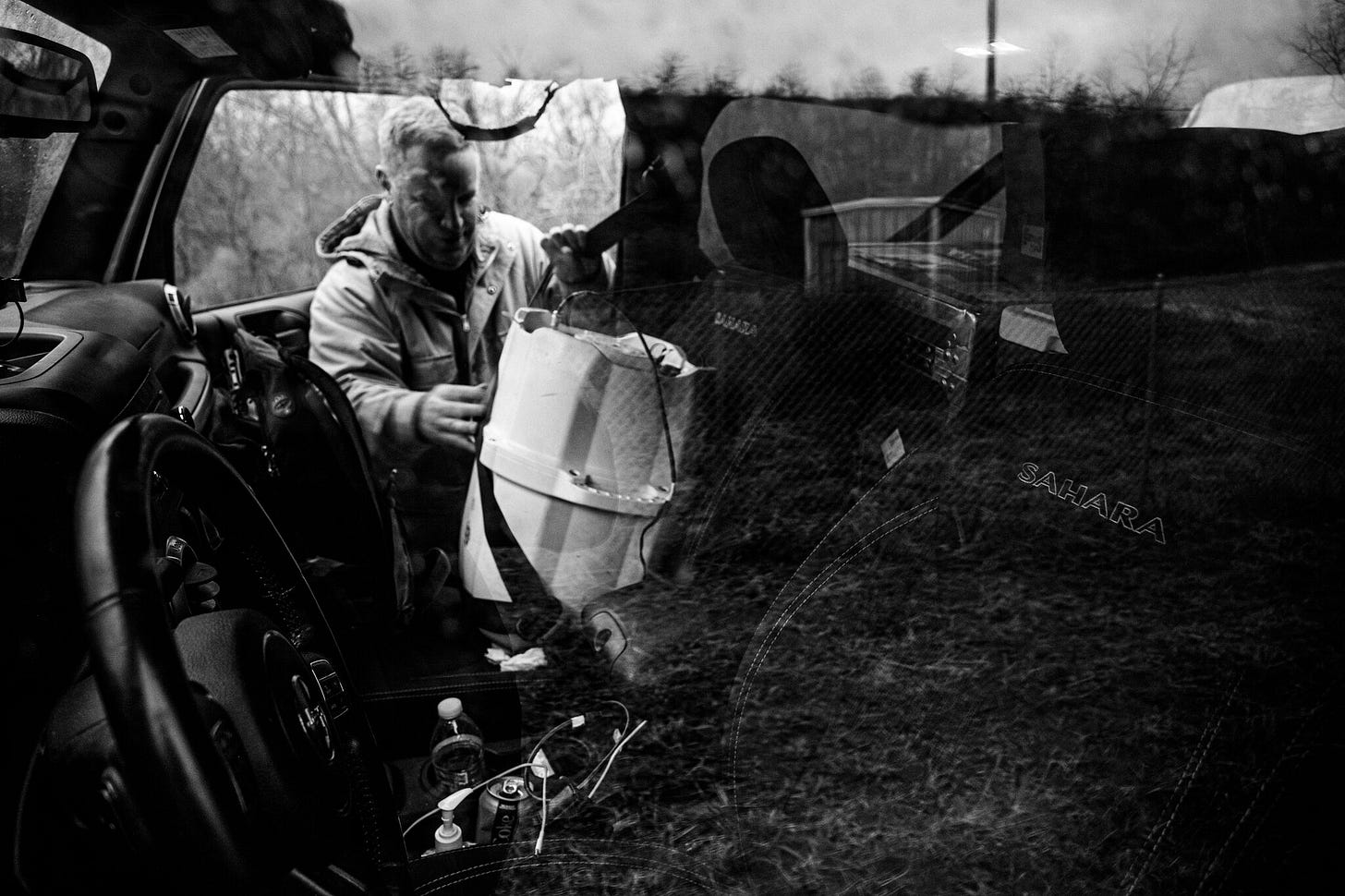
Editor’s note: For the full background and earlier timeline, see our previous report, Oil in the Walls, Booms in the Drains: DEP Says Eureka’s Cleanup Fails to Contain the Damage
On September 12th, DEP sent the following update about Eureka Resources to Public Herald: inspections have continued at the 2nd Street facility in Williamsport after the August 17 spill from Tank N3. (all new inspection records are included at the bottom of this report)
DEP reports that cleanup work remains underway and that Eureka has submitted schedules for waste removal across all three of its facilities.
By September 11, Eureka was reporting that the N3 spill released 11,430 gallons, with 8,424 gallons recovered and 3,000 gallons “not recovered.”
DEP makes clear these are company-supplied estimates, still under review, and must be treated as preliminary. That distinction matters. If DEP accepts lower numbers pushed by Eureka, the company’s fines could be reduced. Public Herald’s whistleblower investigations have already documented how Eureka has misled both workers and the public in the past — a pattern that makes any effort to recast spill totals highly suspect.
When we told Eric Steppe, former Eureka worker turned whistleblower, about the latest numbers change, he said:
“They are bold-faced liars. That’s how they’ve stayed afloat for so long. Burning every bridge laid for them. On occasion I was sent to try and repair something and 4 out of 5 times was told the hardware store or auto parts store was freezing Eureka’s accounts until their debts are paid in full. That’s one of the reasons everything in that hell hole was duct-taped and zip-tied together.”
In contrast to Eureka’s change in spill numbers, DEP’s own records from August documented that 16,000 gallons spilled from Tank N3, which had a total capacity of 26,000 gallons. Those are the official numbers against which Eureka is now trying to substitute its own.
DEP also found that the Williamsport site to-date unlawfully contained 1,378,897 gallons of oil and gas liquid waste stored since July 1, 2024, spread across 70 tanks.
What New Records Show
The latest inspection reports track gallons of oil collected, floors swept, and storm drains managed:
On September 2, inspectors observed new absorbent socks in storm drains, 8,000 gallons recovered from inside the building (after heavy rainfall), and report 30,000–40,000 gallons still onsite per the company’s estimate.
September 4, reports keep the recovery total at 8,424 gallons, with oil-dry applied, storm drains still boomed.
September 5, records confirm 8,424 gallons recovered total, with only the B-side containment still needing cleanup.
September 9, records reveal continued staining on the south wall, B-side residues, and a frac tank being emptied.
September 11, Eureka changes spill total to 11,430 gallons released vs. 8,424 recovered vs. 3,000 unrecovered figures appear — again, company estimates, not DEP’s.
Overall, the records are long on gallons and absorbents, but short on science. None include radium results or plans to test for radioactivity.
The Unanswered Public Health Question: Radioactivity & Radioactive Ingrowth
It is now more than 21 days since the spill. In that time, DEP could have collected and analyzed new tank samples using gamma spectroscopy to establish the radioactive profile of the waste. Yet, none of the Eureka spill inspection reports contain any such data.
Oil and gas waste from fracking contains high concentrations of Technically Enhanced Naturally Occurring Radioactive Materials (TENORM), and wherever this radioactive TENORM waste is stored, water-soluble radionuclides such as Radium-226 are recorded in high concentrations when properly tested.
Public Herald’s earlier reporting on DEP’s 2016 TENORM study revealed that Eureka’s treatment process only removed about 9% of radium from the wastewater it processed in Williamsport. Wastewater entered Eureka’s treatment system “hot” at an average 9,600 pCi/L of combined radium and, after treatment, still measured an average 8,800 pCi/L — leaving treated water thousands of times higher than the federal safe drinking water limit of 5 pCi/L.
That history, alongside what Eureka workers shared with Public Herald about tank N3 and tanks where the remaining wastewater is stored, shows the waste sitting at the 2nd Street site in 2025 would contain high radium concentrations. Without test results, the public has no way to know the radioactive burden of the 16,000+ gallons released from N3 or the thousands of gallons unaccounted for in DEP’s latest reports.
But that’s not the whole story for storing radium.
A further danger lies in the way radium-226 can become more radioactive over time inside storage tanks — a process called radioactive ingrowth.
Radium itself has a long half-life of about 1,600 years, but as it decays it produces radon-222 gas and a cascade of short-lived daughters like polonium and lead isotopes. In a closed system, these decay products accumulate until they reach a balance point known as “secular equilibrium”, when the rate of new daughters being created equals the rate they decay. At that point, the total radiation from the waste is far greater than the original radium alone.
In other words, tanks holding oil and gas wastewater don’t just store radioactivity — their contents can become more radiotoxic the longer they sit.
Here’s what Dr. Daniel Bain, a research professor at University of Pittsburgh’s Department of Geology and Environmental Science who studies radioactivity, had to say about it:
“The problem with all radiation is that it continues to decay and the decay products can be worse than the parent products. Over time it has the potential to turn into something that’s able to admit even more intense ionizing radiation, so you want to avoid that and keep it separate from humans, animals and the entire system.”
“There’s a lot of radium associated with all this and if it doesn’t get put somewhere safe people are going to get hurt. It’s an astonishing amount. Right now they're dumping it on roads in the summer and DEP knows about it and isn’t doing a damn thing. They’re dumping it in landfills and it’s slowly making its way out. And by the time this all gets out it will be too late. In the long run, if it’s delayed by 20 years, you’ve got 20 years of mess to clean up.”
Why Fighting For The Right Number Matters
Eureka’s recalculated spill totals — 11,430 gallons lost, 8,424 recovered, 3,000 unrecovered — are a self-serving attempt to shape the narrative. DEP cautioned that these numbers are “preliminary” and not reviewed. Allowing the company to define the scope of its own disaster raises the risk that penalties will be quietly reduced.
This is not the first time. Public Herald’s whistleblower reporting, published between 2023–2025, showed that Eureka managers downplayed the hazards of fracking wastewater and misled staff about radioactive waste handling. The attempt to substitute company math for independent DEP calculations follows that same pattern.
Company Closure Plans
Eureka has filed a “clean closure process summary” on Aug. 23, pledging to remove all liquid and solid waste from its three facilities. The plan outlines a two-month schedule: pump and truck liquids, vacuum solids, cut open tanks if needed, pressure-wash interiors, and haul residues for disposal. A companion schedule charts September through November for deconstruction and tank cleaning at 2nd Street, Catawissa, and Standing Stone facilities.
But those documents are logistics, not science. They don’t tell us how radioactive the material is, what risks remain at the Williamsport site, where the waste will end up, or how much of the thousands of gallons “not recovered” may have seeped into drains and soil.
By The Numbers, A Historical Comparison
DEP estimate (Aug. 18, 2025): 16,000 gallons spilled from Tank N3 (26,000 gallon capacity).
DEP finding (Aug. 19, 2025): 1,378,897 gallons unlawfully stored onsite across 70 tanks in Williamsport (a similar amount was unlawfully stored at Standing Stone) .
Company’s Sept. 11 estimate: 11,430 gallons spilled; 8,424 recovered; 3,000 unrecovered (preliminary, unverified).
Radium in wastewater (Public Herald reports & 2016 TENORM study): 9,600 pCi/L entering Eureka’s Williamsport treatment; 8,800 pCi/L after treatment — only 9% removed. EPA safe drinking water limit = 5 pCi/L.
What Accountability Requires Now
The latest DEP updates show absorbents deployed, oil dry swept, frac tanks staged, and gallons counted. But none of it answers the real questions.
What was the total radioactive content of the waste spilled from Tank N3? How much radium remains in floors, drains, and stormwater lines? And why, after nearly a month, has DEP not released gamma spectroscopy results that could tell downstream communities the true amount?
Until DEP independently verifies spill totals and publishes radium data, the public is left with what Eureka says happened — numbers that serve the company’s bottom line, not public health.
Our concern is that DEP has held off this long to inform the public about the total amount of radium, a cancer-causing radiotoxin. Due to ongoing public trust issues surrounding DEP, Public Herald is calling for independent testing of Eureka’s tanks, as wells as the plume of pollution, to be performed by Dr. Daniel Bain in his lab at the University of Pittsburgh. Unfortunately, until that’s done, we may never have reliable data about the total radium sitting in Eureka’s tanks; what was released to public waters on August 17; or what’s been released years prior when waste was sent to Williamsport’s POTW and neighboring landfills.
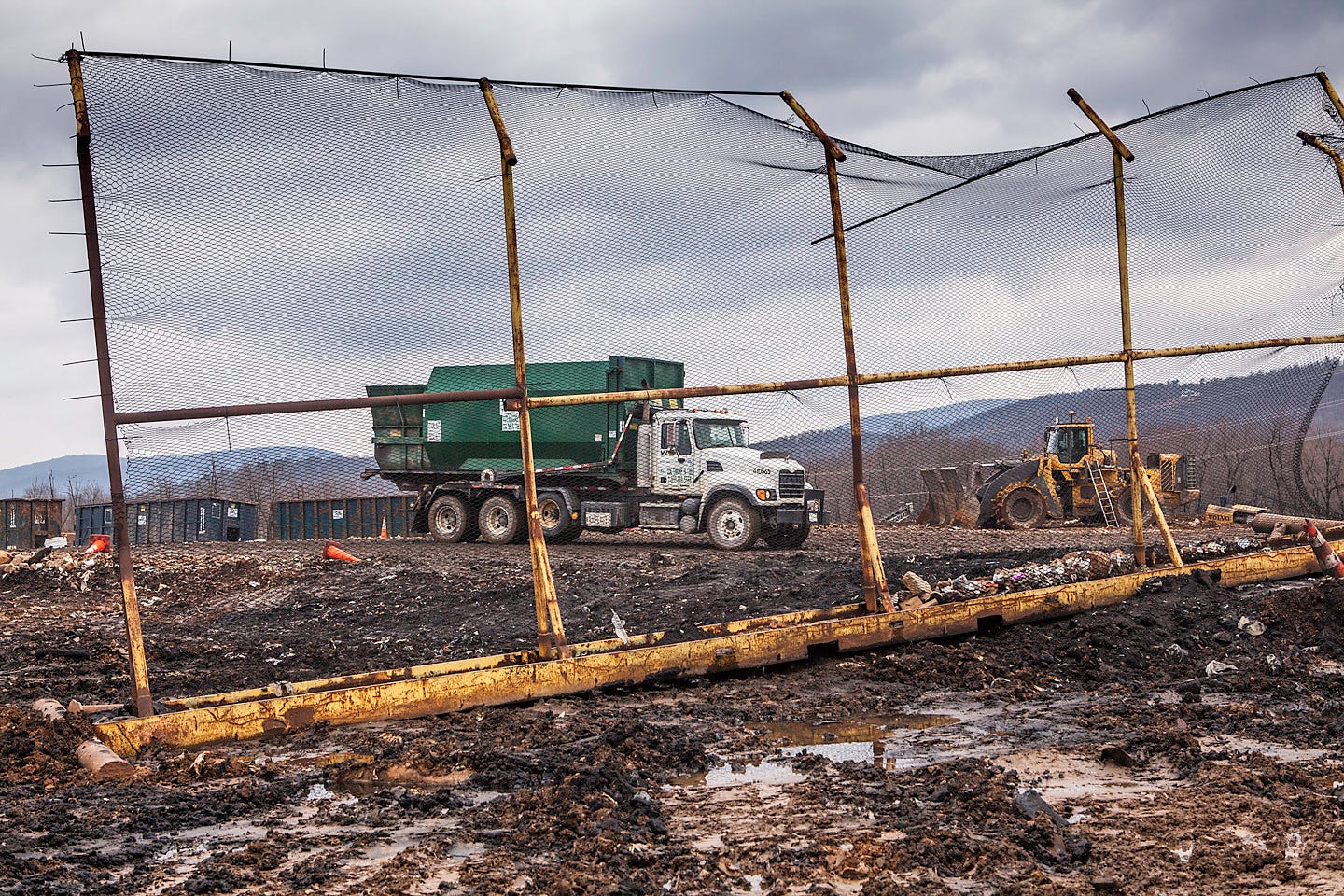
For new readers: SCOOP features a freeform version of Public Herald investigations. Check out the TENORM series for more polished work on this subject.
Review all new inspection records and Eureka communications from DEP
Public Herald & Scoop Coverage of Eureka Resources
Twenty-Six Days Later: DEP Logs Cleanup at Eureka — Still No Radium Tests, & Company Now Floats Lower Spill Totals — Sep 12, 2025 — Quote: “"There’s a lot of radium associated with all this and if it doesn’t get put somewhere safe people are going to get hurt."
Oil in the Walls, Booms in the Drains: DEP Says Eureka’s Cleanup Fails to Contain the Damage from Fracking Waste — Sep 02, 2025 — Quote: “Two Weeks On, Waste Still on the Floor: DEP Tightens Grip on Eureka After Susquehanna Spill”
DEP Releases Update on Eureka Resources — Fails To Use The “Right Test” For Radiation — Aug 22, 2025 — Quote: “DEP cited violations at Eureka’s Standing Stone, Reach Road, and 2nd Street plants, but still failed to require radium-226 testing of wastewater.”
Unlawful Fracking Waste Operations Found at Eureka (The Radioactive Threat to Pittsburgh’s Water) — Aug 21, 2025 — Quote: “Eureka Resources unlawfully stored 1.38 million gallons of fracking waste in 70 tanks for over a year, effectively operating as an unpermitted disposal site.”
Breaking: Eureka Resources Spill Thousands of Gallons of Radioactive Wastewater into West Branch of Susquehanna River — Aug 19, 2025
Quote: “DEP inspectors determined that approximately 16,000 gallons of untreated fracking wastewater escaped from Eureka Resources’ tank farm on 2nd Street in Williamsport into the West Branch Susquehanna River.”“I Turned Blue” — Fracking Workers Share Horrifying Experiences Treating Fracking Wastewater — Dec 10, 2023 — Quote: “One worker recalled collapsing and saying, ‘I turned blue’ after exposure at Eureka Resources while treating radioactive brine.”
Senator Says Pennsylvania Bypassed Feds & Issued “Illegal” Permit That Threatens Dimock Waterways With Radioactivity From Fracking — Aug 29, 2022 — Quote: “DEP’s permit omissions mean companies like Eureka Resources can discharge waste without enforceable limits on radium or other radioactive isotopes.”
We Found The Names of Radioactive Waste Locations That Government Kept Secret — Jan 24, 2022 — Quote: “Our investigation revealed at least 14 facilities—including multiple Eureka Resources plants—handling radioactive oil and gas waste without public disclosure.”
“If Only I Would’ve Known” — Oil & Gas Whistleblowers Speak Out About Exposure to Radioactivity on Fracking Jobs — Dec 14, 2020 — Quote: “Workers at facilities like Eureka Resources describe being ordered to handle concentrated radioactive solids without protective equipment.”
Pennsylvania is Discharging Radioactive Fracking Waste into Rivers as Landfill Leachate — Aug 7, 2019 — Quote: “Eureka’s Standing Stone facility appears in DEP documents as a central processor of radioactive brine contributing to NPDES discharges.”
Investigation: Clorox Selling Pool Salt Made From Fracking Wastewater — Feb 11, 2019 — Quote: “Public Herald traced Eureka Resources’ crystals from treated brine to shelves across America under the Clorox Pool Salt brand.”
newsCOUP Ep. 20: “I Turned Blue” — Workers Share Horrifying Experiences Treating Fracking Wastewater — Dec 2023 — Quote: “A former Eureka employee recounted: ‘I thought I was going to die after breathing in those fumes.’”
newsCOUP Ep. 16: We Found The Names Of Radioactive Waste Locations That Government Kept Secret — Jan 2022 — Quote: “For the first time, the public could see Eureka Resources among the list of secret radioactive waste sites.”
newsCOUP Ep. 1: Clorox Selling Pool Salt Made From Fracking Wastewater — Feb 2019 — Quote: “Clorox was sourcing its pool salt from fracking brine treated at Eureka Resources.”



